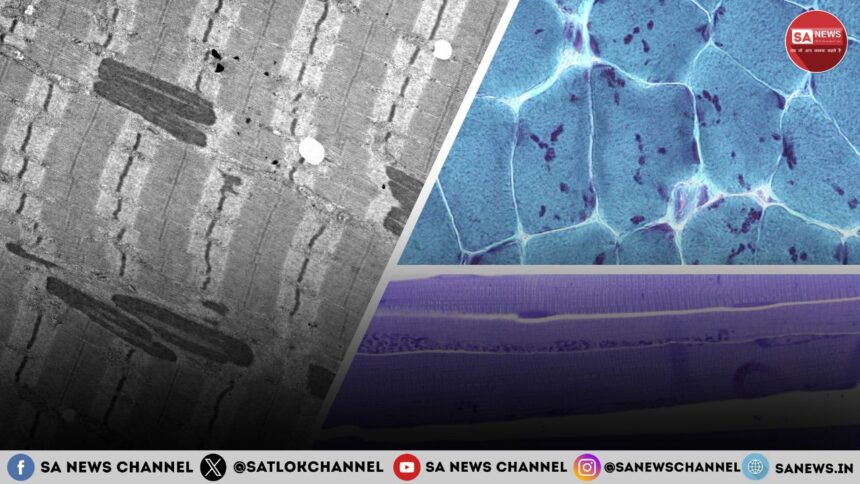Nemaline myopathy (NM) is a condition that weakens the muscles you use to move your body (skeletal muscles). Nemaline myopathy causes muscle weakness (myopathy) in many areas of your body. Symptoms may appear at birth, in childhood, or sometimes in adulthood. Muscle weakness is most common in the following areas of your body:
Are there different types of Nemaline Myopathy?
There are six main types of nemaline myopathy:
- Typical congenital nemaline myopathy: This is the most common type of nemaline myopathy. It accounts for about half of all NM cases.
- Intermediate congenital nemaline myopathy: This type has fewer symptoms than the severe congenital type but more symptoms than the typical congenital type. It occurs in about 20% of cases.
- Severe congenital (neonatal) nemaline myopathy: This condition is present at birth and accounts for about 16% of cases.
- Childhood-onset nemaline myopathy: This type occurs between the ages of 10 and 20 and accounts for about 10% of cases.
- Adult-onset nemaline myopathy: This condition occurs between the ages of 20 and 50, accounting for about 4% of cases.
- Amish nemaline myopathy: This form of the disease primarily affects the Amish community. It is rare and often results in childhood death.
Who can get Nemaline Myopathy?
Nemaline myopathy can affect anyone, regardless of gender, race, or ethnicity. However, it’s more likely to occur if one or both of your parents have nemaline myopathy. You’re at the highest risk for this condition if you have the gene mutation for NM. Members of the Amish community are also at higher risk.
How common is Nemaline Myopathy?
Nemaline myopathy is a rare condition. Researchers estimate that NM occurs in 1 in 50,000 live births. However, in the Amish community, up to 1 in 500 people may have NM.
Symptoms and Causes
What causes Nemaline Myopathy?
Nemaline myopathy is a disease of the musculoskeletal system, usually caused by genetic changes (mutations). One or both of your parents may have the gene mutation associated with this disease. Nemaline myopathy can occur if you inherit one abnormal gene from each parent (autosomal recessive genetic condition). Less commonly, NM can also happen if one parent has the abnormal gene (autosomal dominant genetic condition). Additionally, a new gene mutation that occurs in the egg or sperm cell can also lead to NM.
Most commonly, mutations in the nebulin (NEB) or actin alpha-1 (ACTA1) genes cause nemaline myopathy. Nebulin and actin are proteins that are part of the molecular machinery involved in muscle contraction.
What are the symptoms of Nemaline Myopathy?
The main symptoms of nemaline myopathy include:
- Decreased muscle tone (hypotonia)
- Diminished or absent reflexes
- Muscle weakness
NM symptoms in babies may also include:
- Staggered walking (gait disorder)
- Delayed motor skills, such as sitting, standing, and controlling head movements
- Difficulty speaking (dysarthria) and swallowing (dysphagia)
- A jaw positioned further back than normal (retrognathia)
- Long, narrow face
- Extremely arched roof of the mouth
- Nasal speech (velopharyngeal dysfunction)
- Difficulty breathing during sleep (nocturnal hypoventilation), which increases carbon dioxide levels in the blood (hypercarbia)
- Shortness of breath (dyspnea)
As a person with NM ages, symptoms may include:
- Abnormal stiffness in the spine
- Scoliosis
- Shortening or stiffening of joints (joint contractures)
- Sunken chest (pectus excavatum)
When do symptoms of Nemaline Myopathy start?
Symptoms of this disease can start appearing at any time in life. The age at which symptoms appear can vary; symptoms may start at the same age or at different ages. Some symptoms may appear at any stage in life. Knowing when symptoms appear can help medical providers make an accurate diagnosis.
What is the status of research on Nemaline Myopathy?
In the 1990s, researchers supported by the MDA discovered that defective filament proteins lead to nemaline myopathy. Their work aims to understand the molecular basis of the disease and explore potential treatments. Research efforts to develop treatments for NM continue.
What is the treatment for myopathy?
Answer: Treatment includes oral immunosuppressant drugs, such as methotrexate or corticosteroids, like prednisone.
How common is myopathy?
Answer: The prevalence ranges from 9 to 32 cases per 100,000 people.
Can stress cause myopathy?
Answer: Severe emotional or physical stress can sometimes lead to stress-induced cardiomyopathy.
What is myopathy and neuropathy?
Answer: Myopathy and neuropathy are well-established inherited neuromuscular disorders characterized by progressive weakness and atrophy of distal limb muscles.
How can myopathy be prevented?
Answer: There are no known methods to prevent myopathy.









